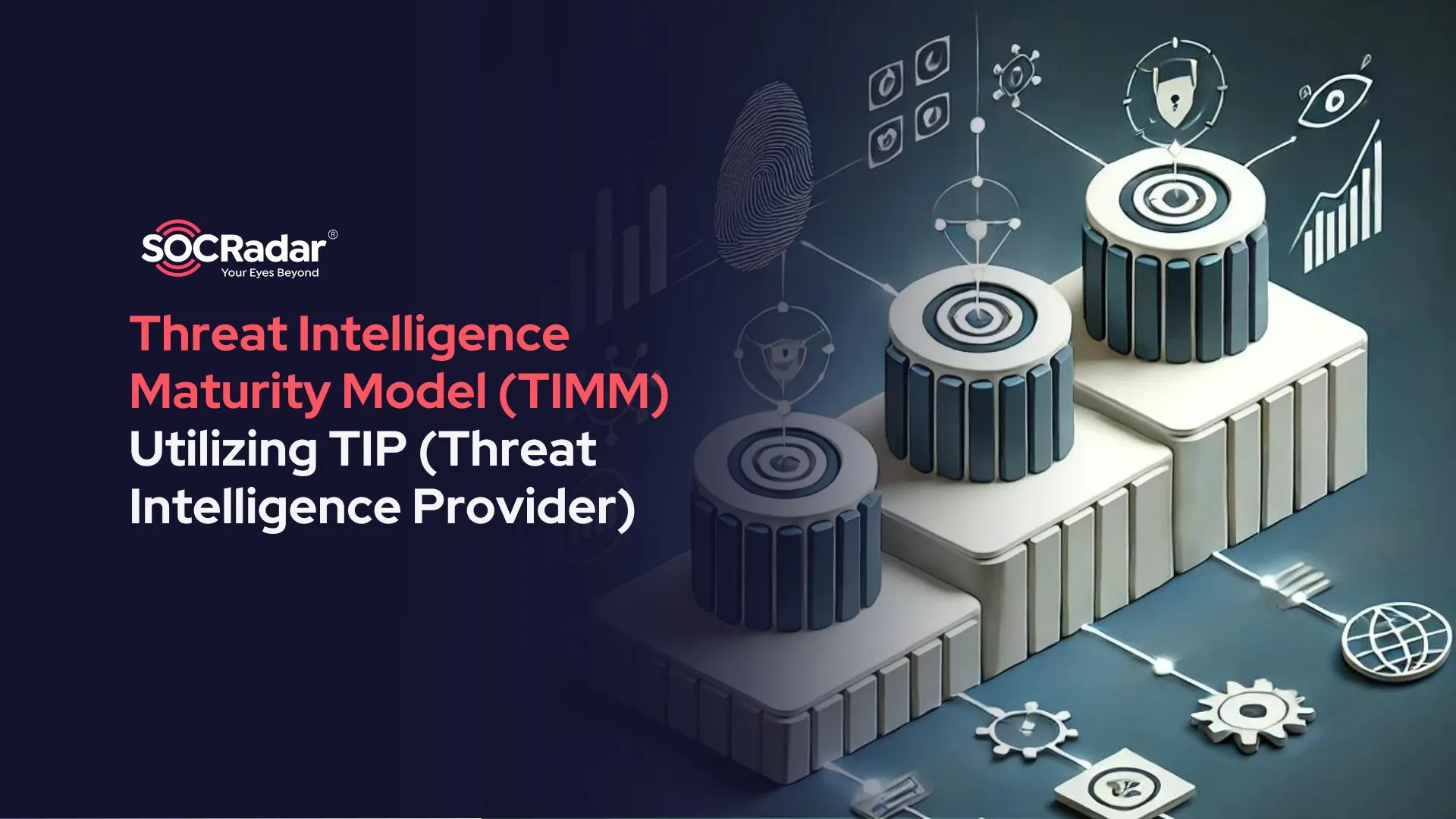
Threat Intelligence Maturity Model (TIMM) – Utilizing TIP
(Threat Intelligence Provider)
Many organizations lack sufficient knowledge about the threats they face and their own security posture as well, making it difficult for them to defend themselves adequately. They need intelligence against those threats, but they don’t know how to start with CTI.
The Threat Intelligence Maturity Model (TIMM) allows organizations to understand themselves and the threat landscape. This understanding allows them to manage their resources better and adopt the necessary intelligence solutions for their needs.
We will cover the basics of the Threat Intelligence Maturity Model and explain how SOCRadar XTI can resolve your worries.
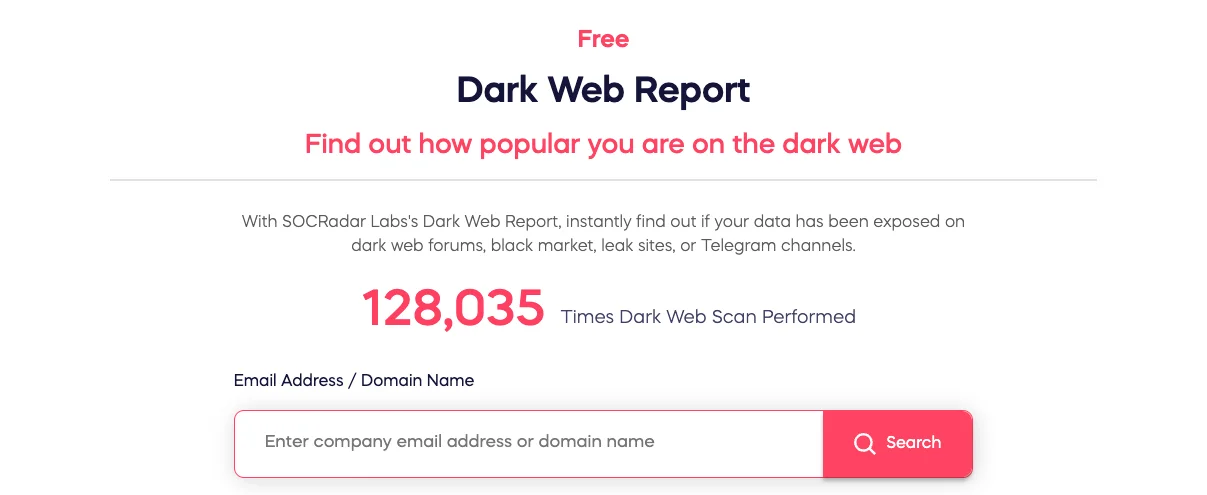
Free Dark Web Report from SOCRadar Labs
What is the Threat Intelligence Maturity Model (TIMM)?
Maturity models are being developed to assist companies in methodically measuring the effectiveness of a process. Since the impact of CTI programs is questioned, the TIMM model helps to understand this process’s efficiency. It gives companies a picture of their current maturity level in terms of CTI and a road map for improvement.
Each TIMM level shows a different level of ability to gather, examine, share, and use threat intelligence. Organizations can prioritize areas for improvement and identify the problems in their security structure to better fight against cyber threats by utilizing the TIMM.
Why is TIMM Important?
The model is important for several reasons. As we mentioned earlier, the main purpose of the model is benchmarking. TIMM allows organizations to benchmark their current threat intelligence capabilities using a framework. This helps identify their strengths and weaknesses. After this benchmarking, organizations can have a clear understanding of their maturity level.
After organizations assess their current status, they can start planning for the future. TIMM offers organizations a path from very basic to advanced threat intelligence capabilities by clearly defining maturity levels. This approach makes allocating resources and developing strategies easier and helps organizations see what’s in front of them.
Companies can use the Threat Intelligence Maturity Model as a thorough guide to build, improve, and maximize their threat intelligence capabilities. This will ultimately result in a more secure and resilient operating environment and better use of capital.
How to Assess Your Maturity Level?
In order to see the future and increase the maturity level, you first need to understand your position. According to enisa, there are 4 maturity levels in TIMM:
- Level 1: Initial
- At this level, everything is unpredictable and reactive.
- Level 2: Managed
- Things are a bit more developed, but they are still inconsistent and mostly reactive.
- Level 3: Repeatable
- Processes are measured and controlled.
- Level 4: Optimized
- The organization is focused on improving the processes.
The whole assessment takes place in 5 general domains. These are Planning, Collection, Production, Evaluation and Dissemination. Additionally, all these domains are reviewed in separate intelligence levels such as Strategic, Operational, Tactical and Technical.
Planning
This domain is about the management and stakeholders’ involvement and responsibility in the CTI process. At the first level, the management is unaware of what CTI is and all the responsibilities related to it. At the last level, the whole CTI process is just part of the decision-making process of the management, and it has a distinct place in every other intelligence level. CTI is included when the management plan something.
| Type / Level | Initial | Managed | Repeatable | Optimized |
| Strategic | Board and senior managers unaware of what CTI is and the team responsible for it | Board and senior managers aware, occasional CTI is offered rarely, if ever, acted upon | Threat intelligence pushed by team on big issues; board receives and considers Information | Threat intelligence a routine part of decision-making, with advice sought on all major decisions |
| Operational | No tasking to identify activity-related attacks or groups who plan attacks openly | Broad tasking to identify whether attacks are occurring as a result of activities | Specific tasking to investigate a group or activity-related attack | Develop capabilities where there is indication of a return on investment |
| Tactical | Consumption of unstructured external information from feeds and news articles. | Regular access to threat data and information from CTI suppliers. | Correlation of external and internal threat data. | Integration of external threat data sources with SIEM. |
| Technical | No specific requirements for technical threat intelligence | Requirements are broad, such as consume all publically available feeds | Requirements are specific and relevant. IoCs for a specific group | Results of evaluation are an active part of requirement setting and management of the process |
CTI Capability Maturity Model, Marco Lourenco
Collection
The Collection domain is about both collecting the data and utilizing it. On the first level, the organization doesn’t collect any data or very little data that comes from basic activities. On the last level, the organization utilizes many sources to collect the data and utilizes that data to secure the organization.
| Type / Level | Initial | Managed | Repeatable | Optimized |
| Strategic | None | Small number of sources consumed. A focus on ‘overview’ style articles or reading other people’s analysis on the same topic | A focus on reputable, well-known sources of information in key areas. | Large range of sources, including economic, sociopolitical, foreign language journals, press articles, and products of other CTI types. |
| Operational | Attempt to analyze data from activity related attacks | Attempts made to find an activity or event correlated to attack types | Activity-related attacks regularly predicted, but no coordinated response | Activities that result in attacks robustly understood, and appropriate monitoring in place. Response planned; |
| Tactical | No tactical information collected | Irregular decision making on source acquisition. Mostly open- or sources of unknown reputation | Regular decision making on source acquisition and re-alignment. Wider range of mostly reputable sources | Established procures to acquire, evaluate and re-alignment sources. |
| Technical | No collection | Ad-hoc collection, e.g. from occasional reports. Indicators are manually actioned, e.g. by logging onto hosts to check for registry paths or looking at firewall logs. | Collection from public feeds. Automatic searching for host-based indictors across the whole infra, probably utilizing third party software. | Collection from public feeds, and private feeds such as sharing relationships. Indicators of all types automatically searched for in network traffic and on hosts; |
CTI Capability Maturity Model, Marco Lourenco
Production
In the Production domain, the organization doesn’t analyze anything if they are on the first level. No data is collected, and therefore, no analysis is done. On the last level, the organization utilizes the sources effectively and the data collected in order to analyze the threat landscape and detect particular threats before being damaged by them. This analysis occurs on all levels of intelligence (Strategic, Operational, Tactical, and Technical).
| Type / Level | Initial | Managed | Repeatable | Optimized |
| Strategic | No analysis; any sources consumed are reported directly | Some analysis of sources and verification of content of overview articles. | Analysis leading to insight that supports publically available reviews and commentary. | Deep analysis, leading to Insight. Mapped to business in a way that takes into account financial drivers, structure and intentions of the organization |
| Operational | No analysis, intelligence from sources is integrated directly | Advanced correlation and trends analysis. Application and database activity monitor | Some analysis of sources and verification of content of overview articles. Some attempt made to map to general businesses | Threats are proactively and strategically managed from a central register; Continuous research is proactively performed to understand known threats |
| Tactical | No integration of external data or information into the analysis. | Basic understanding of attack flow, actors, and tools. | Knowledgebase maintained of how a variety of campaigns that have targeted the organization’s industry functioned at each stage of attack. | Expert-level knowledge maintained on all key attack groups. User behavior and entity analysis. This includes breakdown of tools used, how key stages of the attack are executed. |
| Technical | No application of indicators to organization | Indicators are manually actioned by a staff member, e.g. by logging onto hosts to check for registry paths or looking at firewall logs. | Network-based indicators are automatically investigated by network devices | Indicators of all types automatically searched for in network traffic and on hosts; new indicators that become available are used to search through log data for historical signs of compromise |
CTI Capability Maturity Model, Marco Lourenco
Evaluation
The Evaluation domain has certain similarities with the Planning domain. At the earlier levels, CTI is not included in the decision-making processes but as organizations progress towards the latest levels CTI plays a bigger role in evaluating the given decisions, impacts of the attacks, and efforts of the organization.
| Type / Level | Initial | Managed | Repeatable | Optimized |
| Strategic | CTI not involved in strategic decisions | CTI considered but generally disregarded | CTI generally used in the decisions. such as increased security budget to mitigate a risk. | CTI occasionally changes decisions and regularly affects how those decisions are Implemented |
| Operational | No evaluation | Report prepared, identifying how many alerts were produced by operational threat intelligence and whether they were plausible | Formal process defined for evaluating the success and failure of individual cases | Efforts robustly evaluated, with undetected attacks (where detection should have been possible) subject to root cause analysis |
| Tactical | No evaluation | Random evaluation of the quality of CTI through a ad-hoc review process | Technical evaluation of CTI | Complete review process of the CTI |
| Technical | No evaluation | Monthly report prepared of how many alerts were a result of indicators from specific sources | Monthly report identifies whether verified alerts were generated as a result of an indicator that was also detected by other mechanisms | (Same as previous). Incidents that emerge are analyzed to identify whether technical threat intelligence should have allowed detection sooner. |
CTI Capability Maturity Model, Marco Lourenco
Dissemination
In the earlier stages, the necessary intelligence is not seen by decision-makers. Stakeholders don’t have any clue about the necessary information. But in later stages, CTI becomes part of the decision-making process and this knowledge is consumed wherever it is needed.
| Type / Level | Initial | Managed | Repeatable | Optimized |
| Strategic | CTI is not shared with strategic stakeholders. | Sharing with individuals at similar organizations. Board and senior managers have access to CTI but not considered as decision tool. | Reputation and trust exists on the CTI outcomes but lacks understanding on how to use it | CTI consumed as part of decision-making, with advice sought on all major decisions. |
| Operational | No dissemination. | CTI is shared with operational stakeholders but no actions produced. | CTI shared with operational stakeholders and actions are taken. | CTI is fully integrated with the operational environment. |
| Tactical | No dissemination. | CTI is shared externally but without any specific criteria. No specific attempts to map attacker MO to organizational weaknesses | CTI is shared with specific individuals at other organizations, who would be involved in responding to an attack. | Other organizations have been successfully alerted, allowing them to better protect themselves as a result. |
| Technical | No dissemination. | Informal sharing with a limited audience, e.g. email | Automated sharing of verified indicators | Automated sharing of verified indicators that have been investigated |
CTI Capability Maturity Model, Marco Lourenco
The organizations can check how mature they are by reviewing each “maturity level” for each “intelligence level” and assessing their position. After that, the desired position will be selected as a goal based on the organization’s needs and aims. The gap between them will show what kind of achievements are needed in order to reach that desired level. To reach those achievements, you can look for either working with a CTI provider like SOCRadar XTI (which you can try for free) or maybe building an in-house CTI solution if you have enough capacity and need.
How can SOCRadar Help as a Threat Intelligence Provider?
A threat intelligence provider, like SOCRadar, can play a crucial role in helping organizations progress through the levels of TIMM or in providing the necessary intelligence.

Fundamentals of Dark Web Course, SOCRadar Academy
Sometimes organizations face qualified personnel problems that can hinder the actualization of the achievements needed for improving the organization’s maturity level. SOCRadar Academy provides cybersecurity education for those who are willing to increase their capacity. Training sessions to upskill your management or your employees is a beneficial action to take in order to improve your general cybersecurity posture. You can also try SOCRadar’s AI Workshop to master cybersecurity.
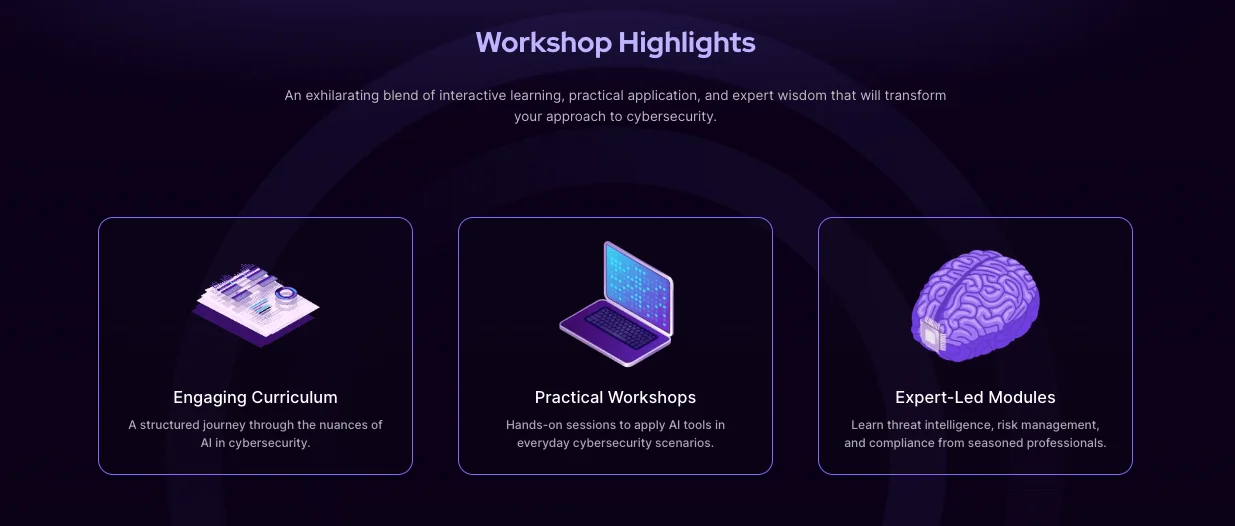
SOCRadar AI Worksop
SOCRadar tools always provide you with related intelligence for your organization in an understandable way and since gathering data is a significant part of any CTI process, SOCRadar’s different modules can help you with this tiresome process by providing you with information for various purposes.
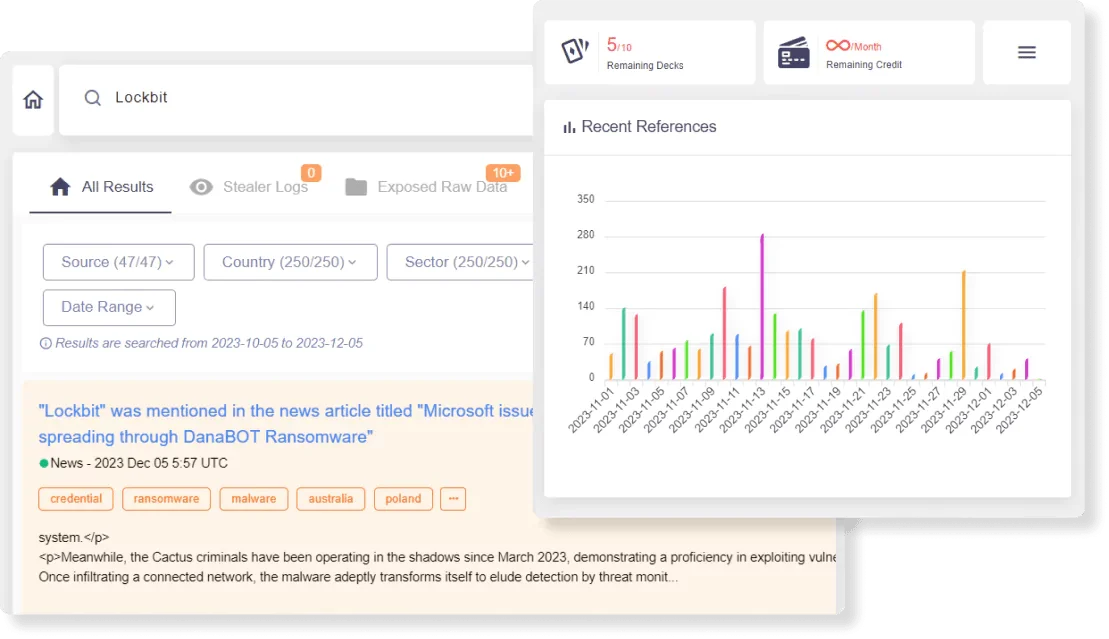
SOCRadar Dark Web Monitoring
Intelligence about threat actors, dark web forums and ransomware news, and vulnerabilities are just some of the data topics we can assist you with. The real-time data we provide can help you hunt down the threats and neutralize them before they damage your organization.
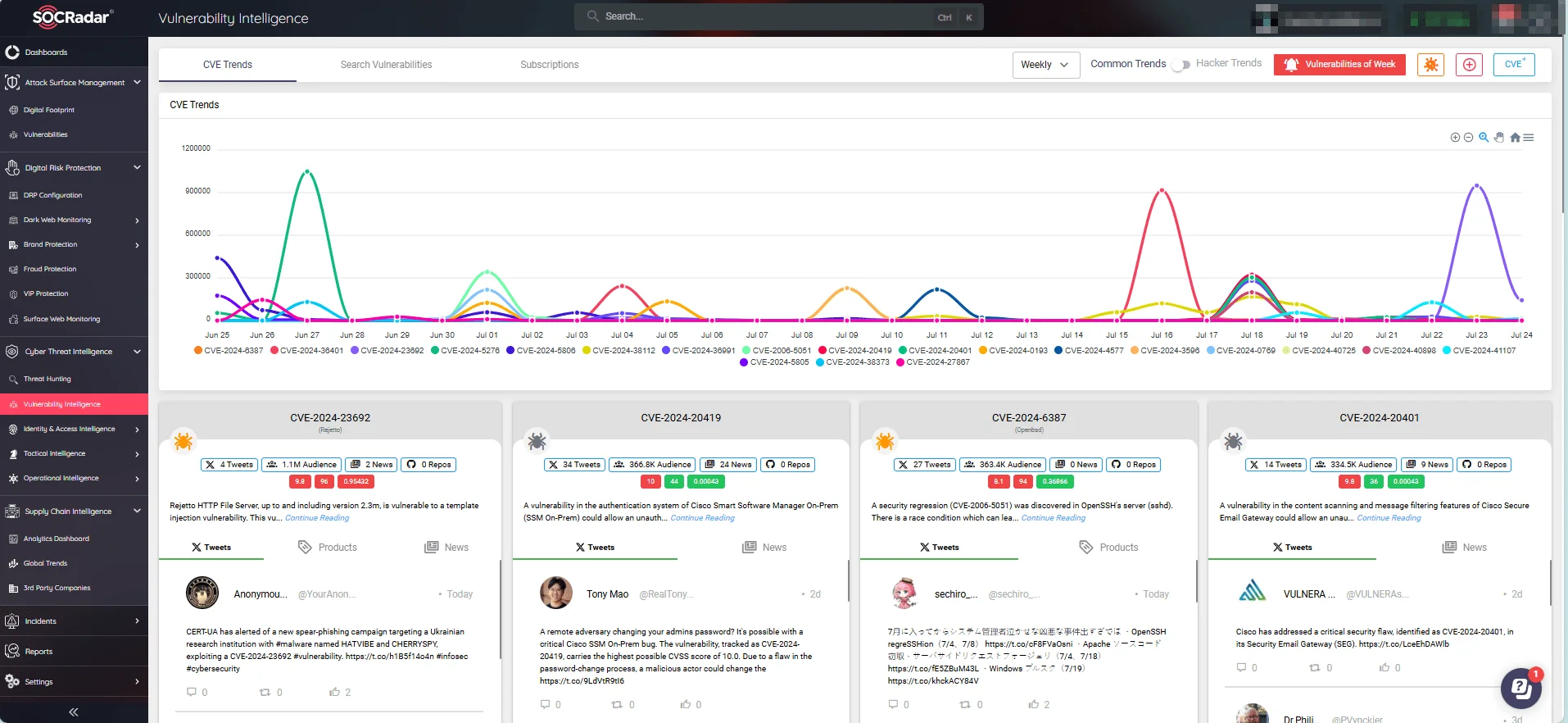
SOCRadar Vulnerability Intelligence
We also offer expert analysis and contextualization of that data to produce actionable intelligence. We do that by sharing intelligence reports where we analyze industries, countries, and regions, publishing blog posts on various topics and threats, and in the reports where we warn our customers about the latest threats. Our analysts also help our clients when they face a problem. Based on your maturity level, you can include the data from SOCRadar XTI in your CTI program.

SOCRadar Intelligence Reports
The modules we provide to our clients also help them to get the necessary intelligence. Our XTI Platform makes aggregating, analyzing, and sharing threat intelligence a lot easier. The integration possibilities we offer also makes the whole process smoother.
Lastly, the partners of SOCRadar and its extensive network allow us to collaborate with different organizations worldwide, which is a great way to improve the quality of intelligence we all gather. This helps all of our customers.
As you can see, SOCRadar XTI offers solutions to a wide range of CTI needs. Whether your maturity level is 1 or 4, you can find something that you will utilize in order to increase your security posture.
Conclusions
In this article, we saw the Threat Intelligence Maturity Model (TIMM), its benefits, how it can be implemented, and how SOCRadar can help you with your needs.
Overall, planning for your needs in CTI is an important step. In terms of TIMM, understanding your initial stage is the most important thing you should do. Without this step, it will be nearly impossible to satisfy the needs of your organization fully. This assessment phase involves recognizing your capabilities, behaviours of the organization and the gaps you have. After this foundational understanding, you can work to improve your security posture.
While you are working on your security posture, SOCRadar can help you at every stage of your journey.




































